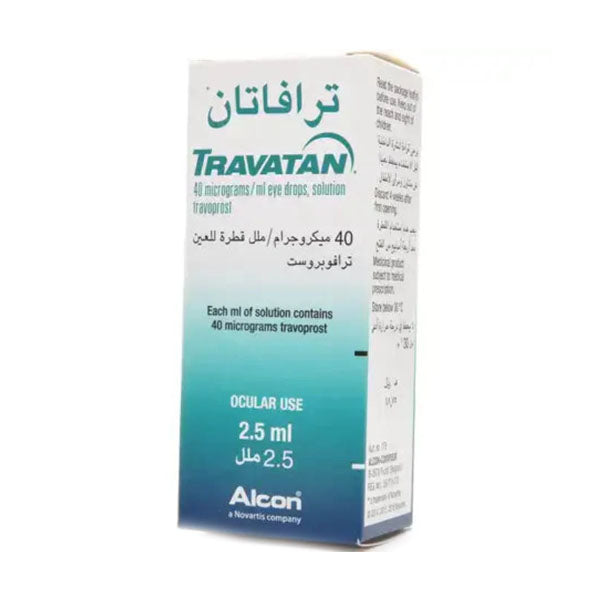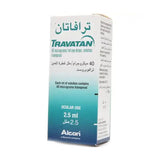Travatan eye drops 2.5 ml:
Travoprost eye drop solution 40 mcg/ml.
What is the use of travoprost?
- Travoprost is a medicine that belongs to a class of medicines called 'prostaglandin analogues'.
- It is used to reduce high eye pressure in children 2 months of age and older, teenagers, and adults.
- Increased eye pressure may lead to glaucoma (increased pressure in the eye that can lead to vision loss).
- Travoprost can be used alone or with other eye drops (such as beta blockers), which also help reduce eye pressure.
KHow to use travoprost:
grown ups
- The recommended dose is one drop in the affected eye once daily at night.
- Do not put eye drops in both eyes unless prescribed by your doctor.
children
- The recommended dose for children 2 months of age and older is the same as the recommended dose for adults.
- This medication is not recommended for use in children under 2 months of age.
Instructions for use:
- Use your medication exactly as prescribed by your doctor. Talk to your doctor or pharmacist if you are not sure.
- Open the packaging bag of the bottle immediately before using it for the first time and write the opening date on the carton in the designated space.
- wash your hands. Remove the bottle cap. Tilt your (or your child's) head slightly back and pull the lower eyelid down to create a pocket.
- Place the drop over the eye with the tip facing down. Look up and away from the bottle.
- Avoid contact of the eye drop tip with the eye or other surfaces to prevent bacterial contamination that may lead to eye infection and serious eye damage.
- Then squeeze the container to release a drop. Leave the lower eyelid and close the eyes for one minute. If you miss an eye drop, repeat the steps.
- Wipe any excess drops from your (or your child's) cheeks. Repeat the steps with the other eye if your doctor tells you to put your medication in both eyes.
- Close the bottle cap tightly when you are finished using it.
- Contact your doctor if you suspect that your eye drops are contaminated.
- You should only use one bottle at a time.
- If you are using more than one eye drop solution, be sure to take each at least five minutes apart.
- Use the medication at the same time every day.
- Do not stop using the medicine without consulting your doctor.
Do not use travoprost:
- If you are allergic to travoprost, or any other ingredients this medication contains. Tell your doctor about the symptoms you experience.
Warnings and precautions:
- Talk to your doctor or pharmacist if you experience an allergic reaction such as shortness of breath, rash, swelling of the face or neck.
- This medication may be absorbed through your skin. Make sure to avoid the drop coming into contact with your skin. If this happens, wash your skin immediately especially if you are pregnant or planning to become pregnant.
- This product contains hydrogenated castor oil and propylene glycol which may cause skin irritation and reactions.
- This medication may rarely cause shortness of breath, wheezing, or worsening symptoms of asthma (a respiratory problem that causes difficulty breathing and wheezing). Talk to your doctor right away if you notice any changes in your breathing pattern.
- This medication may cause changes in the color, growth, length, thickness, color, direction, and number of your eyes and eyelashes. The change in your eye color may increase during treatment. Color changes may not be noticed until months or years have passed.
- Once you stop using this medication, your eye color change is expected to be permanent, unlike the eyelashes and area around the eyes which are expected to regain their original color.
- Make sure to remove contact lenses before using eye drops. You can wear contact lenses again at least 15 minutes after applying the eye drops.
- Avoid contact of the eye drop tip with the eye to prevent bacterial contamination.
- Seek your doctor's advice if you are planning surgery (eg cataract surgery).
- If you are using more than one eye drop solution, be sure to take each at least five minutes apart.
- Talk to your doctor before starting this medication if you have an eye infection.
Possible side effects:
- Very common side effects include eye redness.
- Common side effects include eye pain, eye discomfort, dry eyes, eye irritation, changes in iris color and itchy eyes.
- Uncommon side effects include corneal disorder, eye discharge and tears, sensitivity to light, eyelid itching, inflammation or infection of the conjunctiva, eye inflammation, eyelid crusting, clouding of the eye, abnormal outward deviation of the lower eyelid, iritis, inflammation of the inside of the eye, inflammation of the surface of the eye. Eye with or without superficial damage, blurred vision, inflammation of the eyelids, eyelid redness, growth of eyelashes, swelling around the eye, headache, darkening of the skin, hair growth, increased signs of allergies, irregular heartbeat, abnormal hair texture, stuffy nose, darkening Skin around the eyes, cough and throat irritation.
- The most common side effects seen when using this medication in children and teenagers are eyelash growth and eye redness.


